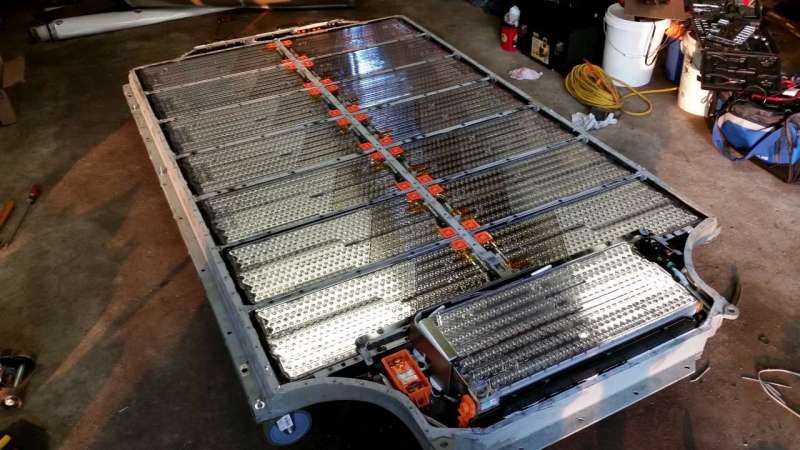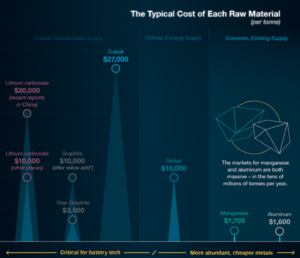Come As You Are – Lithium, Cobalt, and Tesla’s Battery Problem

Tesla's in rarefied air, but rare earth metals may bury them.
Tesla is the moonshot company with outsize expectations. In news reports, they are often mentioned with the same kind of head-shaking wonder and disbelief usually reserved for sports commentators; traditionally skeptical bloggers have written lengthy, fawning posts about their CEO, Elon Musk; [1] respected fiction authors have included thinly-veiled depictions of him quite literally saving the world. [2] No surprise, since he has been a champion for climate change as the most imminent and credible threat to human survival. When asked why he released Tesla’s patents to the public in 2014, he commented: “We’re all on the same ‘ship’ (being Earth)… if there are a bunch of holes in the ship, and we have a nice bucket design, it would be foolish not to share it.” [3]





Sourcing ethics questions dogging global manufacturers is nothing new. But given its market position, there may be an opportunity for Tesla to lead on more than just the climate change front. As one of the world’s soon-to-be largest consumers of numerous rare materials, they will wield significant market power to effect changes in the processes and outcomes of their sourcing and supply chain. In terms of priorities, I would recommend that Tesla:
- Review and design a set of sourcing principles along environmental, humanitarian, and quality rubrics that will guide supply chain and sourcing decisions
- Conduct a comprehensive audit and review of all current sourcing firms
- Partner with willing suppliers to adhere to new standards, and replace resistant or non-compliant suppliers
Tesla has a mission to save the world; but in its eagerness to bail a sinking ship, Tesla should remember not to trample those in the way.
Word Count: 782
Sources
[1] Wait But Why. 2016. How Tesla Will Change The World – Wait But Why. [ONLINE] Available at: http://waitbutwhy.com/2015/06/how-tesla-will-change-your-life.html. [Accessed 04 November 2016].
[2] Neal Stephenson, 2015. Seveneves: A Novel. First Edition Edition. William Morrow.
[3] MSNBC. (2014). One on One with Elon Musk. [Online Video]. 1 April 2015. Available from: https://youtu.be/OG2ESgvtoMA?t=2m11s. [Accessed: 3 November 2016].
[4] U.S. Patent Office, (2013), U.S. Patent D683,268 [ONLINE]. Available at: http://patft.uspto.gov/netacgi/nph-Parser?Sect2=PTO1&Sect2=HITOFF&p=1&u=/netahtml/PTO/search-bool.html&r=1&f=G&l=50&d=PALL&RefSrch=yes&Query=PN/D683268 [Accessed 4 November 2016].
[5] Keywords to understanding Sony Energy Devices|Sony Energy Devices Corporation. 2016. Keywords to understanding Sony Energy Devices|Sony Energy Devices Corporation. [ONLINE] Available at: http://www.sonyenergy-devices.co.jp/en/keyword/. [Accessed 04 November 2016].
[6] TechSci Research. 2016. Lithium Ion Battery Market to Grow at CAGR 17% Till 2021 Says TechSci Research. [ONLINE] Available at: http://www.prnewswire.com/news-releases/lithium-ion-battery-market-to-grow-at-cagr-17-till-2021-says-techsci-research-585713901.html. [Accessed 04 November 2016].
[7] Tesla Motors club user [wk057], (2014), Tesla Model S Battery Teardown [ONLINE]. Available at: http://hackaday.com/2014/09/13/tesla-model-s-battery-teardown/ [Accessed 4 November 2016].
[8] Electrek. 2016. Reports: Tesla evaluating a partnership with Chilean state-owned mining company Codelco to source lithium in the country | Electrek . [ONLINE] Available at: https://electrek.co/2015/12/03/reports-tesla-evaluating-a-partnership-with-chilean-state-owned-mining-company-codelco-to-source-lithium-in-the-country/. [Accessed 04 November 2016].
[9] Electrek. 2016. Tesla tried and failed to buy a lithium startup for $325 million | Electrek . [ONLINE] Available at: https://electrek.co/2016/06/09/tesla-buy-simbol-lithium-startup-325-million/. [Accessed 04 November 2016].
[10] Josh Mcdonald, (2016), Untitled [ONLINE]. Available at: http://www.teslarati.com/new-photos-show-future-gigafactory-expansion/ [Accessed 4 November 2016].
[11] Electrek.co | Fred Lambert, (2016), Tesla Infographic [ONLINE]. Available at: https://electrek.co/2016/11/01/breakdown-raw-materials-tesla-batteries-possible-bottleneck/ [Accessed 4 November 2016].
[12] Enrique Marcarian / Reuters, (2012), Untitled [ONLINE]. Available at: http://photoblog.nbcnews.com/_news/2013/04/05/17616570-powering-your-electronics-south-americas-lithium-triangle [Accessed 4 November 2016].
[13] Child labour behind smart phone and electric car batteries | Amnesty International. 2016. Child labour behind smart phone and electric car batteries | Amnesty International. [ONLINE] Available at: https://www.amnesty.org/en/latest/news/2016/01/child-labour-behind-smart-phone-and-electric-car-batteries/. [Accessed 04 November 2016].
[14] The Guardian. 2016. Children as young as seven mining cobalt used in smartphones, says Amnesty | Global development | The Guardian. [ONLINE] Available at: https://www.theguardian.com/global-development/2016/jan/19/children-as-young-as-seven-mining-cobalt-for-use-in-smartphones-says-amnesty. [Accessed 04 November 2016].



Great post Will!
I’ll be interested to see where this discussion goes in the next 10-15 years. Global consumption for rare earth minerals is certainly going to accelerate as LiON battery technology proliferates further and the global population grows. Do you think Tesla – and Musk – is prepared to take up the mantle as a global leader in sustainable mining practices? Or, as in the case of Ikea, should they look at supporting globally recognized standards?
Alternatively, can Tesla take a position as a developer of sustainable mining and enriching practices since its consumption of rare earth minerals is so large?
Wow – definitely learned a lot from this Will, it certainly sounds like supply chain issues will only be a matter of time should Tesla continue on their Moon-wards trajectory. I really hope that they will be able to step up, as the previous poster suggested, and take an ethical stance on this, it would certainly seem in-fitting with the brand, but perhaps this is too much to imagine. There are just so many different battery technologies and my knowledge of chemistry is just so very weak, that it’s very hard to know whether Lithium-ion is the correct horse to be backing or whether Vanadium, Redox-flow etc. etc. will be better long term alternatives! Time will tell, but I agree that reliance on rare earths is a significant weakness. Cheers!
Will,
I enjoyed reading this post.
Given the above, I was wondering why Tesla is not investing in a proper Cobalt mine in Congo? With Codelco in Chile and large proven reserves in North Argentina / South Bolivia, the Lithium supply will not be an issue. Cobalt on the other hand is difficult to source in large quantities from ‘reliable’ sources.
On a more fundamental note, why is Tesla not looking at Hydrogen as an energy carrier? Hydrogen is made out of water, and when burnt, it turns back into water…
Will,
Great topic, I learnt a considerable about from this post! I especially enjoyed and agree with Elon Musk’s analogy quoted at the very beginning of your article. The underlying question here is: How far do you go down the chain to push your products? And how can you ensure that they are all addressing the very problem Musk sought out to solve.
Your recommendation regarding influencing supply chain decisions to adopt sustainable integration reminded me very much of the concept of virtual integration of Ikea forests. To pgoedertier’s comment above, if Lithium and Cobalt is an essential component to this production might it make sense for Tesla to consider manage their mining activities?
With all these innovating weapons Musk is using to battle climate change and in light of Tesla’s cash flow problems, I wonder which projects he will let sink and what others will continue to develop. Let’s hope this makes the cut.
Smells like Tesla’s spirit could get us out of this mess. I know that they are looking into fuel cells for solar energy storage as well. I’d be curious to see what other battery technology they are pursuing both in terms of design and material composition. As others have mentioned, there are multitudes of other battery technologies. In the pacemaker and defibrillator industry, battery design is critical, not only in terms of amp-hours/size or weight, but in predictability of battery depletion. Products need to be engineered so as to alert the patients and physicians in some way before the battery completely dies (and potentially the patient). I imagine Tesla faces additional, perhaps less obvious, design challenges that may limit the type/composition of battery they produce. Whatever route they choose, I agree with your assessment of the steps that should be taken to ensure the raw materials are sourced in a credible and sustainable way. Only then will they achieve Nirvana!
Thanks for shedding light on this topic Will. As the world’s largest producer of Li batteries the gigafactory certainly will be in a position to set the tone for sustainable sourcing. It’s good to see that they are partnering with Codelco to source Chilean lithium but what about their Cobalt plans? Is it possible for them to source Cobalt without purchasing from DR Congo?